Metabolic Profile of Histomonas meleagridis in Dwyer’s Media with and Without Rice Starch
Abstract
1. Introduction
2. Materials and Methods
2.1. Histomonas meleagridis Strain Preparation
2.2. Sample Collection and Preparation
2.3. Data Analysis
3. Results
3.1. Histomonas meleagridis Growth
3.2. Growth of Undefined Bacteria
3.3. Metabolic Profile of H. meleagridis and Undefined Bacterial Populations in Dwyer’s Media with and Without Rice
4. Discussion
Supplementary Materials
Author Contributions
Funding
Institutional Review Board Statement
Data Availability Statement
Acknowledgments
Conflicts of Interest
References
- Hess, M.; Liebhart, D.; Bilic, I.; Ganas, P. Histomonas Meleagridis—New Insights into an Old Pathogen. Veter. Parasitol. 2015, 208, 67–76. [Google Scholar] [CrossRef] [PubMed]
- McDougald, L.R.; Cervantes, H.M.; Jenkins, M.C.; Hess, M.; Beckstead, R. Protozoal Infections. In Diseases of Poultry; John Wiley & Sons, Ltd.: Hoboken, NJ, USA, 2020; pp. 1192–1254. ISBN 978-1-119-37119-9. [Google Scholar]
- Liebhart, D.; Sulejmanovic, T.; Grafl, B.; Tichy, A.; Hess, M. Vaccination against Histomonosis Prevents a Drop in Egg Production in Layers Following Challenge. Avian Pathol. 2013, 42, 79–84. [Google Scholar] [CrossRef] [PubMed]
- Liebhart, D.; Hess, M. Spotlight on Histomonosis (Blackhead Disease): A Re-Emerging Disease in Turkeys and Chickens. Avian Pathol. 2020, 49, 1–4. [Google Scholar] [CrossRef] [PubMed]
- Mazumdar, R.; Nöbauer, K.; Hummel, K.; Hess, M.; Bilic, I. Molecular Characterization of Histomonas Meleagridis Exoproteome with Emphasis on Protease Secretion and Parasite-Bacteria Interaction. PLoS ONE 2019, 14, e0212429. [Google Scholar] [CrossRef] [PubMed]
- Clark, S.; Kimminau, E. Critical Review: Future Control of Blackhead Disease (Histomoniasis) in Poultry. Avian Dis. 2017, 61, 281–288. [Google Scholar] [CrossRef]
- Dwyer, D.M. An Improved Method for Cultivating Histomonas Meleagridis. J. Parasitol. 1970, 56, 191–192. [Google Scholar] [CrossRef]
- van der Heijden, H.M.J.F.; Landman, W.J.M. Improved Culture of Histomonas Meleagridis in a Modification of Dwyer Medium. Avian Dis. 2007, 51, 986–988. [Google Scholar] [CrossRef]
- Barrios, M.A.; Kenyon, A.; Beckstead, R. Development of a Dry Medium for Isolation of Histomonas Meleagridis in the Field. Avian Dis. 2017, 61, 242–244. [Google Scholar] [CrossRef]
- Hauck, R.; Armstrong, P.I.; McDougald, L.R. Histomonas Meleagridis (Protozoa: Trichomonadidae): Analysis of Growth Requirements in Vitro. J. Parasitol. 2010, 96, 1–7. [Google Scholar] [CrossRef]
- van der Heijden, H.M.J.F.; McDougald, L.R.; Landman, W.J.M. High Yield of Parasites and Prolonged in Vitro Culture of Histomonas Meleagridis. Avian Pathol. 2005, 34, 505–508. [Google Scholar] [CrossRef]
- Bilic, I.; Hess, M. Interplay between Histomonas Meleagridis and Bacteria: Mutualistic or Predator–Prey? Trends Parasitol. 2020, 36, 232–235. [Google Scholar] [CrossRef] [PubMed]
- Ganas, P.; Liebhart, D.; Glösmann, M.; Hess, C.; Hess, M. Escherichia Coli Strongly Supports the Growth of Histomonas Meleagridis, in a Monoxenic Culture, without Influence on Its Pathogenicity. Int. J. Parasitol. 2012, 42, 893–901. [Google Scholar] [CrossRef] [PubMed]
- Rabinowitz, J.D.; Kimball, E. Acidic Acetonitrile for Cellular Metabolome Extraction from Escherichia Coli. Anal. Chem. 2007, 79, 6167–6173. [Google Scholar] [CrossRef] [PubMed]
- Kamphorst, J.J.; Fan, J.; Lu, W.; White, E.; Rabinowitz, J.D. Liquid Chromatography–High Resolution Mass Spectrometry Analysis of Fatty Acid Metabolism. Anal. Chem. 2011, 83, 9114–9122. [Google Scholar] [CrossRef] [PubMed]
- Lu, W.; Clasquin, M.F.; Melamud, E.; Amador-Noguez, D.; Caudy, A.A.; Rabinowitz, J.D. Metabolomic Analysis via Reversed-Phase Ion-Pairing Liquid Chromatography Coupled to a Stand Alone Orbitrap Mass Spectrometer. Anal. Chem. 2010, 82, 3212–3221. [Google Scholar] [CrossRef]
- Chambers, M.C.; Maclean, B.; Burke, R.; Amodei, D.; Ruderman, D.L.; Neumann, S.; Gatto, L.; Fischer, B.; Pratt, B.; Egertson, J.; et al. A Cross-Platform Toolkit for Mass Spectrometry and Proteomics. Nat. Biotechnol. 2012, 30, 918–920. [Google Scholar] [CrossRef]
- Martens, L.; Chambers, M.; Sturm, M.; Kessner, D.; Levander, F.; Shofstahl, J.; Tang, W.H.; Römpp, A.; Neumann, S.; Pizarro, A.D.; et al. mzML—A Community Standard for Mass Spectrometry Data. Mol. Cell. Proteom. 2011, 10, R110.000133. [Google Scholar] [CrossRef]
- Clasquin, M.F.; Melamud, E.; Rabinowitz, J.D. LC-MS Data Processing with MAVEN: A Metabolomic Analysis and Visualization Engine. Curr. Protoc. Bioinforma. 2012, 37, 14.11.1–14.11.23. [Google Scholar] [CrossRef]
- Melamud, E.; Vastag, L.; Rabinowitz, J.D. Metabolomic Analysis and Visualization Engine for LC-MS Data. Anal. Chem. 2010, 82, 9818–9826. [Google Scholar] [CrossRef]
- Chong, J.; Wishart, D.S.; Xia, J. Using MetaboAnalyst 4.0 for Comprehensive and Integrative Metabolomics Data Analysis. Curr. Protoc. Bioinforma. 2019, 68, e86. [Google Scholar] [CrossRef]
- García-Angulo, V.A. Overlapping Riboflavin Supply Pathways in Bacteria. Crit. Rev. Microbiol. 2017, 43, 196–209. [Google Scholar] [CrossRef] [PubMed]
- Schwechheimer, S.K.; Park, E.Y.; Revuelta, J.L.; Becker, J.; Wittmann, C. Biotechnology of Riboflavin. Appl. Microbiol. Biotechnol. 2016, 100, 2107–2119. [Google Scholar] [CrossRef] [PubMed]
- Kaneko, K.; Aoyagi, Y.; Fukuuchi, T.; Inazawa, K.; Yamaoka, N. Total Purine and Purine Base Content of Common Foodstuffs for Facilitating Nutritional Therapy for Gout and Hyperuricemia. Biol. Pharm. Bull. 2014, 37, 709–721. [Google Scholar] [CrossRef] [PubMed]
- Averianova, L.A.; Balabanova, L.A.; Son, O.M.; Podvolotskaya, A.B.; Tekutyeva, L.A. Production of Vitamin B2 (Riboflavin) by Microorganisms: An Overview. Front. Bioeng. Biotechnol. 2020, 8, 570828. [Google Scholar] [CrossRef] [PubMed]
- Palmieri, N.; de Jesus Ramires, M.; Hess, M.; Bilic, I. Complete Genomes of the Eukaryotic Poultry Parasite Histomonas Meleagridis: Linking Sequence Analysis with Virulence/Attenuation. BMC Genomics 2021, 22, 753. [Google Scholar] [CrossRef]
- Krishnan, A.; Kloehn, J.; Lunghi, M.; Soldati-Favre, D. Vitamin and Cofactor Acquisition in Apicomplexans: Synthesis versus Salvage. J. Biol. Chem. 2020, 295, 701–714. [Google Scholar] [CrossRef]
- Riboflavin (Vitamin B2). In Handbook of Vitamins; Rucker, R.B., Zempleni, J., Suttie, J.W., McCormick, D.B., Eds.; CRC Press: Boca Raton, FL, USA, 2012; ISBN 978-0-429-18905-0. [Google Scholar]
- Thakur, K.; Tomar, S.K.; De, S. Lactic Acid Bacteria as a Cell Factory for Riboflavin Production. Microb. Biotechnol. 2015, 9, 441–451. [Google Scholar] [CrossRef]
- Sepúlveda Cisternas, I.; Salazar, J.C.; García-Angulo, V.A. Overview on the Bacterial Iron-Riboflavin Metabolic Axis. Front. Microbiol. 2018, 9, 1478. [Google Scholar] [CrossRef]
- Nutrient Requirements of Poultry: Ninth Revised Edition, 1994; National Academies Press: Washington, DC, USA, 1994; ISBN 978-0-309-04892-7.
- McDougald, L.R. Blackhead Disease (Histomoniasis) in Poultry: A Critical Review. Avian Dis. 2005, 49, 462–476. [Google Scholar] [CrossRef]
- Couch, J.R.; German, H.L.; Knight, D.R.; Sparks, P.; Pearson, P.B. Importance of the Cecum in Intestinal Synthesis in the Mature Domestic Fowl. Poult. Sci. 1950, 29, 52–58. [Google Scholar] [CrossRef]
- Barros, T.L.; Vuong, C.N.; Latorre, J.D.; Cuesta, R.S.; McGill, E.; Rochell, S.J.; Tellez-Isaias, G.; Hargis, B.M. Feed Composition and Isolate of Histomonas Meleagridis Alter Horizontal Transmission of Histomonosis in Turkeys. Proof of Concept. Front. Veter. Sci. 2022, 9, 937102. [Google Scholar] [CrossRef] [PubMed]
- Maeda, Y. Axenic Growth of Dictyostelium Discoideum Wild-Type NC-4 Cells and Its Relation to Endocytotic Ability. Microbiology 1983, 129, 2467–2473. [Google Scholar] [CrossRef]
- Clark, C.G.; Diamond, L.S. Methods for Cultivation of Luminal Parasitic Protists of Clinical Importance. Clin. Microbiol. Rev. 2002, 15, 329–341. [Google Scholar] [CrossRef] [PubMed]
- Lo, H.-S.; Reeves, R.E. Riboflavin Requirement for the Cultivation of Axenic Entamoeba Histolytica. Am. J. Trop. Med. Hyg. 1979, 28, 194–197. [Google Scholar] [CrossRef] [PubMed]
- Soldo, A.T.; Merlin, E.J. The Cultivation of Symbiote-Free Marine Ciliates in Axenic Medium. J. Protozool. 1972, 19, 519–524. [Google Scholar] [CrossRef]
- Wang, Y.; Eum, J.H.; Harrison, R.E.; Valzania, L.; Yang, X.; Johnson, J.A.; Huck, D.T.; Brown, M.R.; Strand, M.R. Riboflavin Instability Is a Key Factor Underlying the Requirement of a Gut Microbiota for Mosquito Development. Proc. Natl. Acad. Sci. USA 2021, 118, e2101080118. [Google Scholar] [CrossRef]

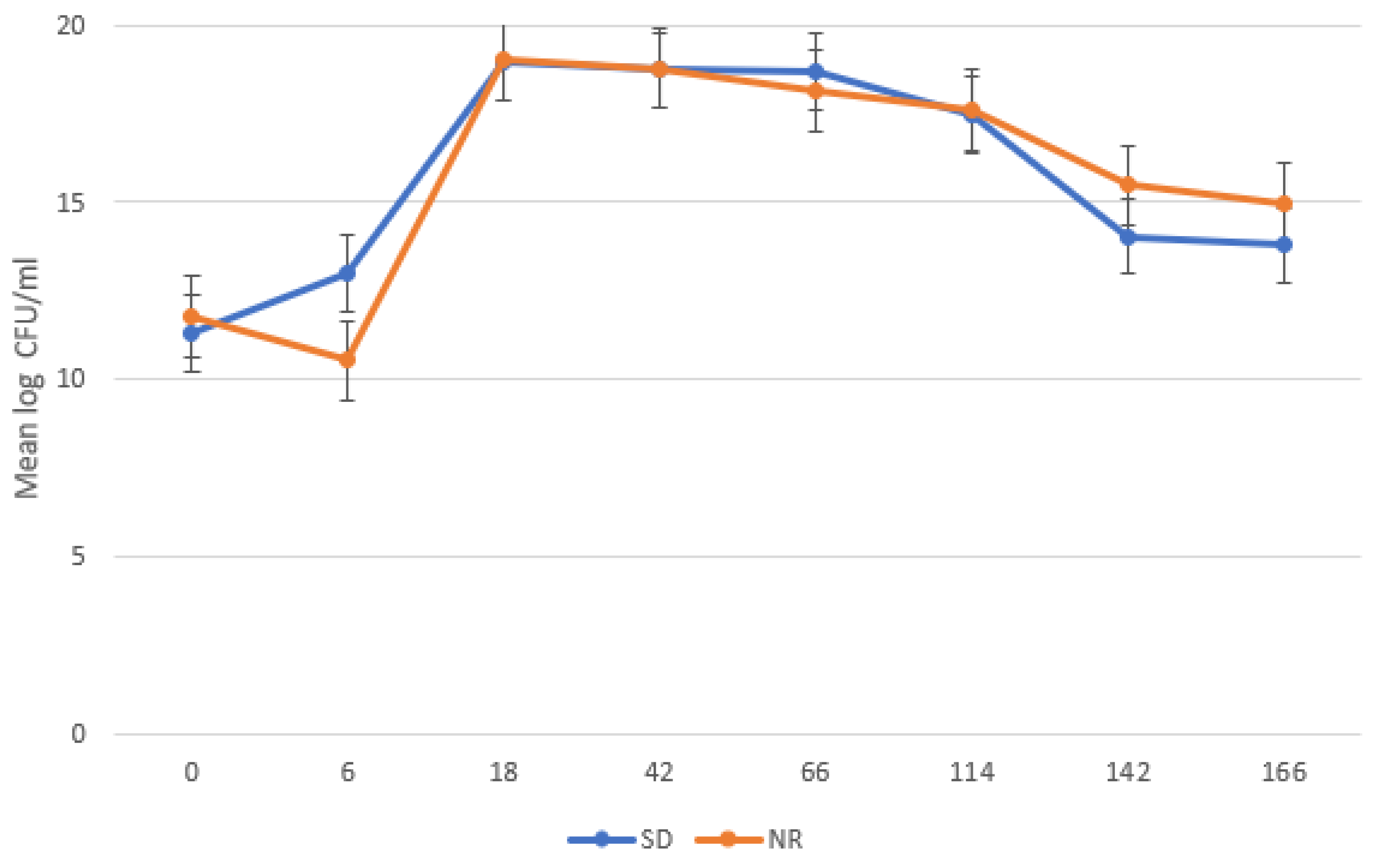
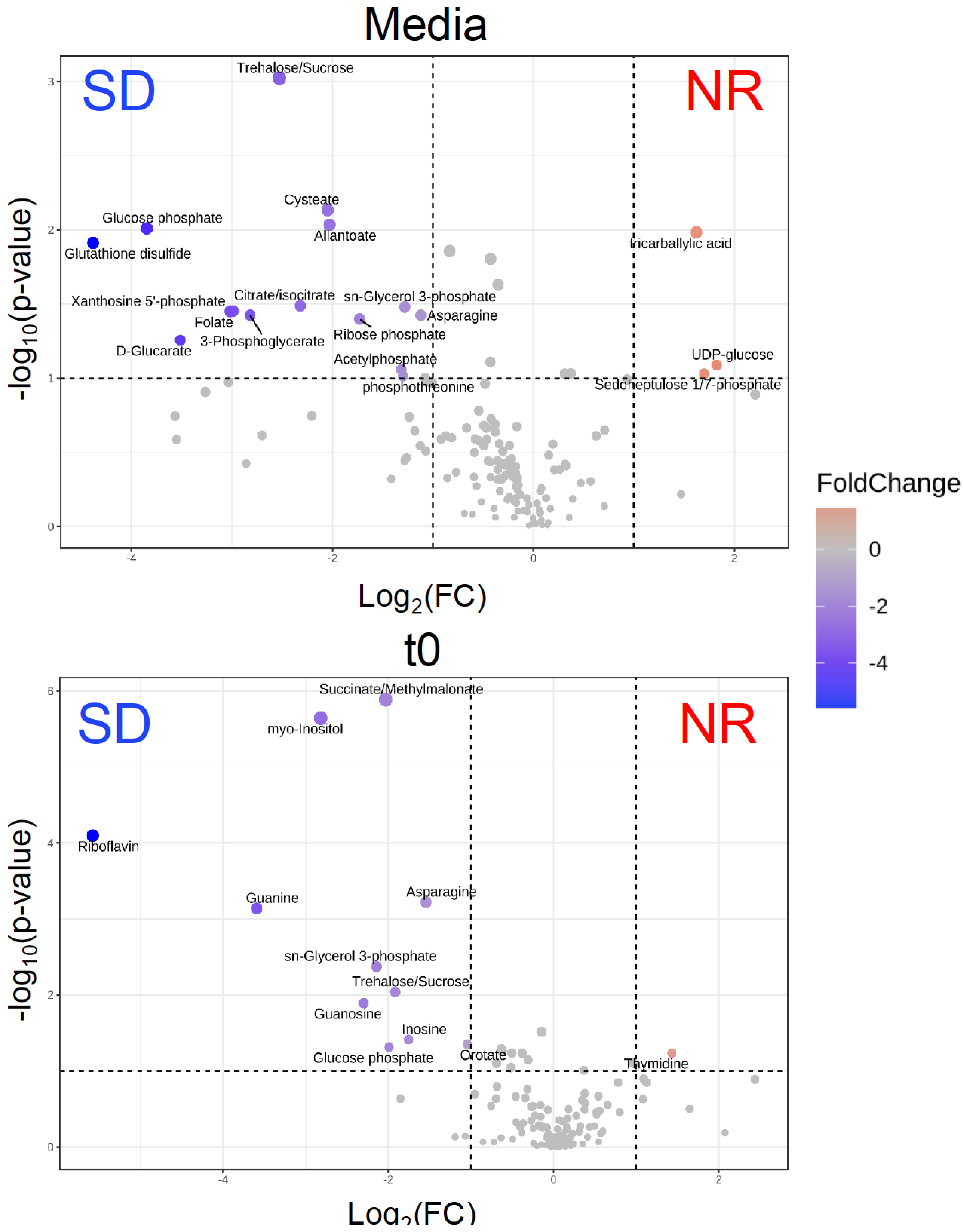
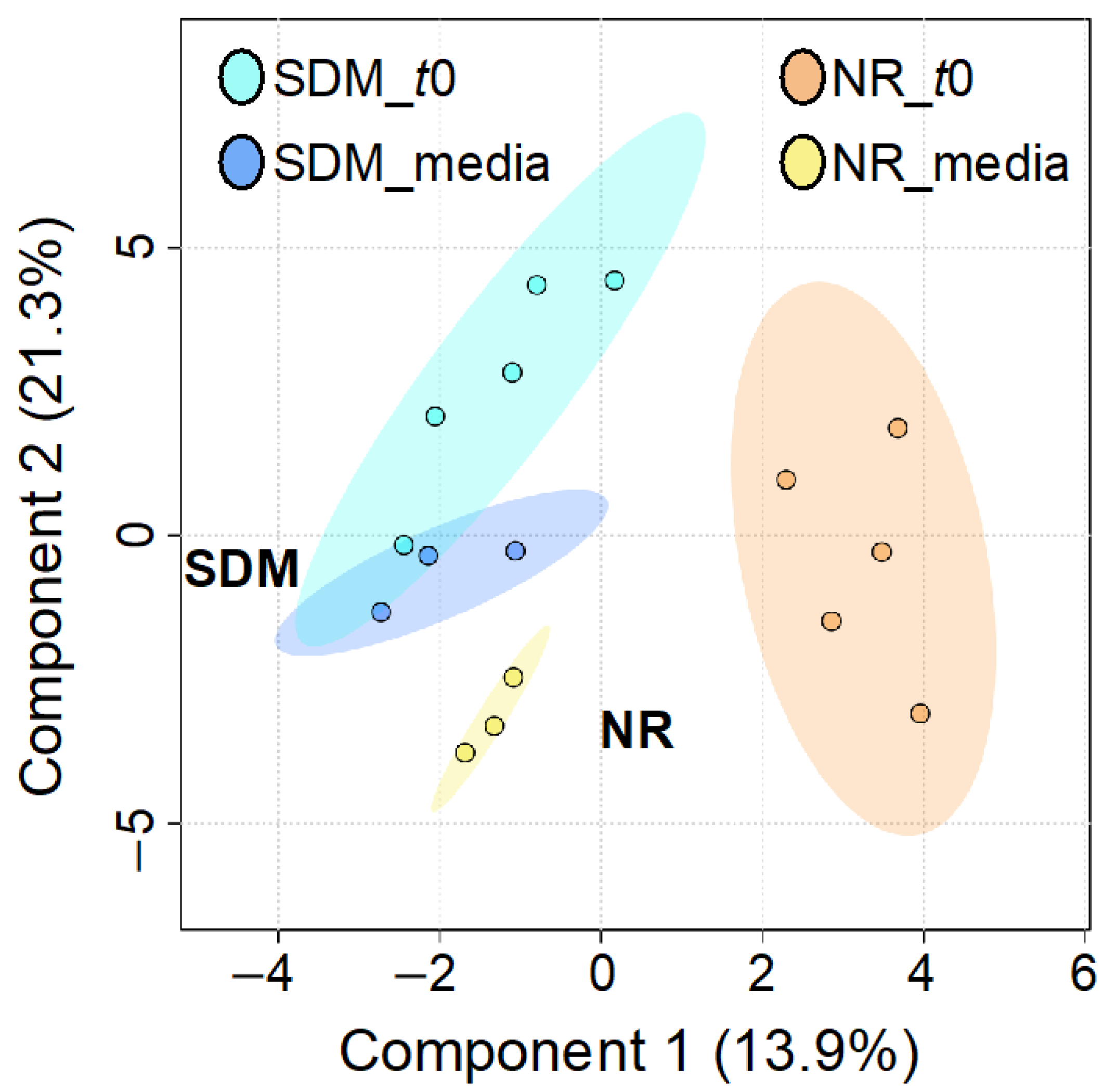
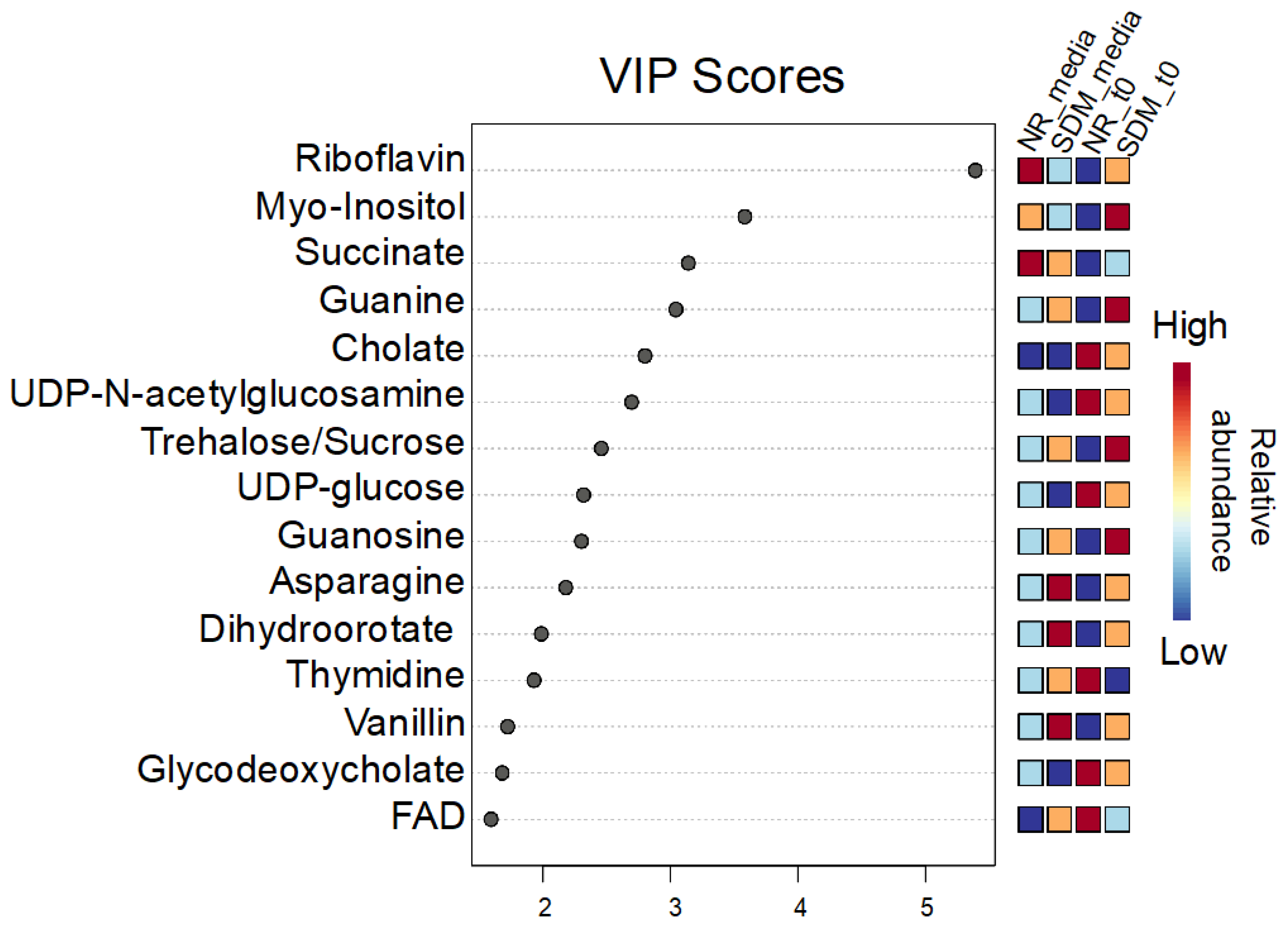
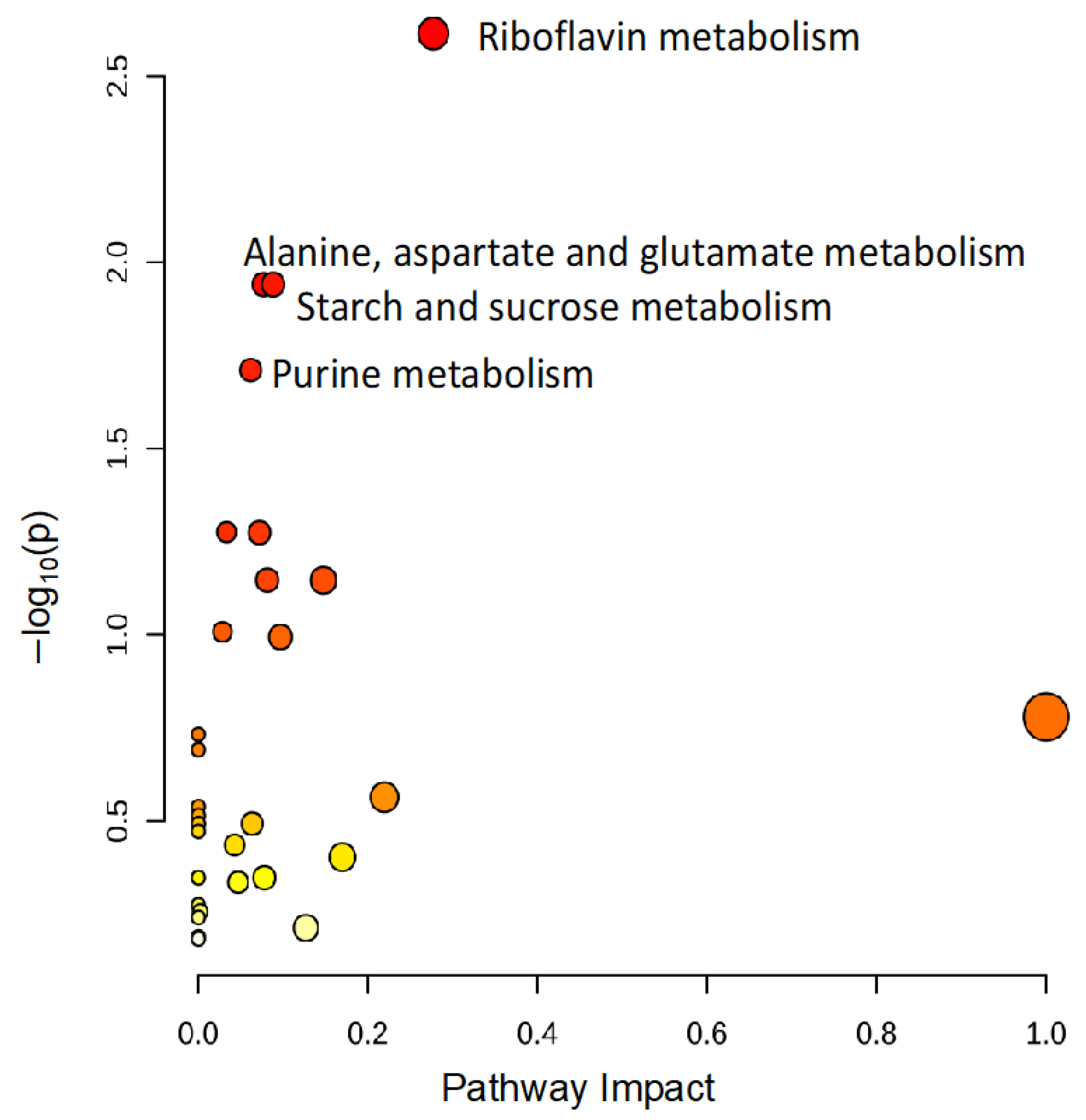

Disclaimer/Publisher’s Note: The statements, opinions and data contained in all publications are solely those of the individual author(s) and contributor(s) and not of MDPI and/or the editor(s). MDPI and/or the editor(s) disclaim responsibility for any injury to people or property resulting from any ideas, methods, instructions or products referred to in the content. |
© 2024 by the authors. Licensee MDPI, Basel, Switzerland. This article is an open access article distributed under the terms and conditions of the Creative Commons Attribution (CC BY) license (https://creativecommons.org/licenses/by/4.0/).
Share and Cite
Ammar, S.; Christopher, C.J.; Szafranski, N.; Jones, R.; Rajeev, S.; Castro, H.F.; Campagna, S.R.; Gerhold, R. Metabolic Profile of Histomonas meleagridis in Dwyer’s Media with and Without Rice Starch. Metabolites 2024, 14, 650. https://doi.org/10.3390/metabo14120650
Ammar S, Christopher CJ, Szafranski N, Jones R, Rajeev S, Castro HF, Campagna SR, Gerhold R. Metabolic Profile of Histomonas meleagridis in Dwyer’s Media with and Without Rice Starch. Metabolites. 2024; 14(12):650. https://doi.org/10.3390/metabo14120650
Chicago/Turabian StyleAmmar, Sawsan, Courtney J. Christopher, Nicole Szafranski, Rebekah Jones, Sree Rajeev, Hector F. Castro, Shawn R. Campagna, and Richard Gerhold. 2024. "Metabolic Profile of Histomonas meleagridis in Dwyer’s Media with and Without Rice Starch" Metabolites 14, no. 12: 650. https://doi.org/10.3390/metabo14120650
APA StyleAmmar, S., Christopher, C. J., Szafranski, N., Jones, R., Rajeev, S., Castro, H. F., Campagna, S. R., & Gerhold, R. (2024). Metabolic Profile of Histomonas meleagridis in Dwyer’s Media with and Without Rice Starch. Metabolites, 14(12), 650. https://doi.org/10.3390/metabo14120650




